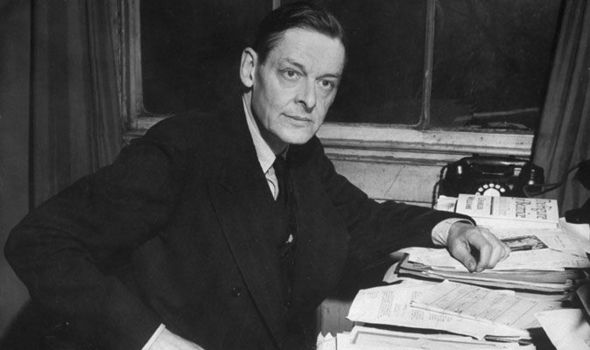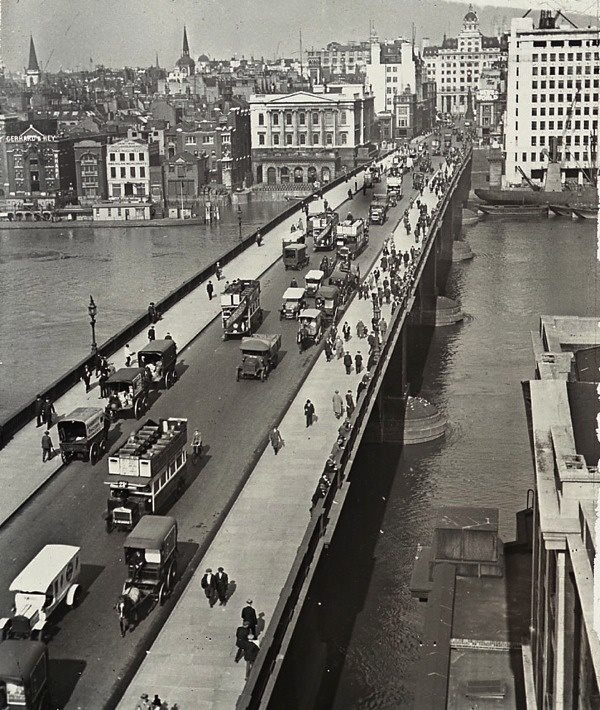Shall I say, I have gone at dusk through narrow streetsAnd watched the smoke that rises from the pipesOf lonely men in shirt-sleeves, leaning out of windows? …
Tom Eliot was not a flâneur, or at least not in the sense that he was an idle wanderer and observer of the city streets. But he used the device of the flâneur in his poetry, particularly in The Waste Land and Prufrock. The London he wrote about was the one he observed as he walked to and from the office, before and after each day’s work. Eliot was consciously not an idler, but prided himself on being a producer of wealth at the heart of London’s financial core. Nonetheless, ‘outside of hours he was a poet. And watching, witnessing, writing about the crowd, he was a poet’.[1] Whether consciously or unconsciously, Eliot gave the nineteenth-century flâneur-observer ideas of Baudelaire a modernist psychological interpretation in works such as Prufrock. In his poetry, he fuses the realistic with the phantasmagoric and the everyday with the fantastic.
Streets that follow like a tedious argumentOf insidious intent
For Eliot London was not just any city but the supreme city of the modern age; the heart of a great but decaying empire and still the world’s commercial and financial capital. He settled in London in 1917 having found both his home city of St Louis and his almae matres of Harvard and Oxford far too provincial for his tastes.
London fired Eliot’s imagination. But, when we read The Waste Land, we do not see a world illumined by light but one of fire-revealed darkness:
Unreal City,Under the brown fog of a winter dawn,A crowd flowed over London Bridge, so many,I had not thought death had undone so many.Sighs, short and infrequent, were exhaled,And each man fixed his eyes before his feet.
When Eliot arrived in London he discovered a city ground down by war and with many of the best of its younger generation already sacrificed on the battlefields of France and Belgium. He found a London that was indeed the cultured, urbane society he had longed to embrace while still a young man in Missouri, but at the same time he sensed a rising tide of something that was spiritually and morally degenerate.
The Love Song of J. Alfred Prufrock is the centrepiece of Eliot’s first collection of London poems and in Prufrock we see his proto-flâneur. He is a wanderer of the city’s night-time streets and an observer of the denizens of its darker reaches. Prufrock, perhaps like his creator, is at once bold and also reticent and he invites us to join him in his nocturnal wanderings:
Let us go then, you and I,When the evening is spread out against the skyLike a patient etherized upon a table;Let us go, through certain half-deserted streets,
But he is torn between the drawing room with its ‘porcelain, among some talk of you and me’ and the grimy city streets of the city where he yearns for ‘the yellow fog that rubs its back upon the window-panes’. The genteel world indoors represents conventionality and respectability whereas the streets suggest something freer, darker and a whisper of sexual possibility.
In Portrait of a Lady, another poem in the Prufrock collection, the narrator takes tea with his would-be lover, conjuring up a vision of bourgeois respectability, but he longs all the while to take her out with him into the streets; for the two of them to share all that the shaded underbelly of the city represents:
— Let us take the air, in a tobacco trance,Admire the monuments,Discuss the late events,Correct our watches by the public clocks.Then sit for half an hour and drink our bocks.
In the same year that Eliot brought out Prufrock he also published a prose piece in the Little Review titled Eeldrop and Appleplex – I. The essay centres on an imaginary conversation between the two protagonists of the title, characters whom one suspects are thinly disguised versions of Eliot and his friend Ezra Pound.
Eeldrop and Appleplex’s conversation ranges over their mutual interest in experiencing the more visceral aspects of the city. The only meaningful point of contact, or moment of shared understanding, between the human psyche and the modern city is in the steady, sustained gaze of the flâneur. We cannot inhabit a city, Eeldrop suggests, but through our spectatorship we can bear witness to it. More than that, he suggests, the actions of the flâneur allow us to decode the city.
By the time he published The Waste Land in 1922 Eliot’s modernist conception of the city was fully formed. In this work he abandons any pretence of presenting a temporal sequence of events and instead lays before us an array of images linked only by their spatial form. These images do not follow on one from the other, rather they are arranged one next to the other in a seemingly random manner.
This sequence of images, Eliot seems to suggest, is analogous to our experience of the modern city. We cannot comprehend the city as a whole. Like the flâneur, we can only experience the city as the handful of images at which we gaze. At best we can attempt to piece together a puzzle that can never be completed.
And this new character living in a modern metropolitan time and place seemed to demand new techniques. The job of the ‘modernist’ artist was not to represent the modern panorama but to render the shifting internal lie of an individual consciousness, to present the spasmodic, the obscure the fragmentary, the failure.[2]
[1] Peter Brooker, Modernity and Metropolis: Writing, Film and Urban Formations (Basingstoke and New York, Palgrave, 2002) p. 25
[2] ibid. p. 52



